Chemical Storage and Segregation - UCLA - Environment, Health ...
Chemical Storage and Segregation - UCLA - Environment, Health ...
Chemical Storage and Segregation - UCLA - Environment, Health ...
Create successful ePaper yourself
Turn your PDF publications into a flip-book with our unique Google optimized e-Paper software.
Fact Sheet<br />
ENVIRONMENT,<br />
HEALTH & SAFETY<br />
Why is <strong>Chemical</strong> <strong>Storage</strong> <strong>and</strong> <strong>Segregation</strong> Important?<br />
Be Safe, Stay Informed<br />
EH&S Facts<br />
<strong>Chemical</strong> <strong>Storage</strong> <strong>and</strong> <strong>Segregation</strong><br />
The safe storage of hazardous chemicals is an essential part of laboratory safety. <strong>Chemical</strong> storage facilities must<br />
meet certain minimum st<strong>and</strong>ards to satisfy diverse regulations, such as those of Cal/OSHA (see Cal/OSHA Laboratory<br />
St<strong>and</strong>ard), the local sanitation district, the California Fire Code <strong>and</strong> University guidelines (see <strong>UCLA</strong> <strong>Chemical</strong> Hygiene<br />
Plan). This fact sheet provides guidelines to help you meet these st<strong>and</strong>ards.<br />
What Must be Done for ALL <strong>Chemical</strong>s in Labs?<br />
y Date all chemicals on receipt <strong>and</strong> keep an up-to-date chemical inventory.<br />
y Label storage areas <strong>and</strong> cabinets to identify the hazardous nature of chemicals stored within (see Chemistry Safety<br />
Labels).<br />
y Properly identify <strong>and</strong> label all chemicals before storing (see Chemistry Safety Labels). <strong>Chemical</strong> labels should<br />
include the chemical name, date, <strong>and</strong> the user’s name or intials.<br />
y Store chemicals in a cool <strong>and</strong> dry location with caps or lids tightly closed. No<br />
chemical residue should be on the outside of the container <strong>and</strong> containers must not<br />
be stacked on top of each other.<br />
y Store <strong>and</strong> arrange in compatible chemical families rather than in alphabetical<br />
order (see chart on page 2). <strong>Chemical</strong>s may be arranged in alphabetical order within<br />
compatible families.<br />
y Particularly Hazardous Substances (PHS) should be purchased in the smallest<br />
quantities possible <strong>and</strong> must be isolated <strong>and</strong> properly labeled. Warning labels<br />
specific to the hazard associated with the chemical must be affixed to: storage areas, cabinets, containers, <strong>and</strong><br />
secondary containers (see PHS Fact Sheet <strong>and</strong> <strong>UCLA</strong> Policy 907: Safe H<strong>and</strong>ling of PHS).<br />
Warning Labels: Particularly Hazardous Substances<br />
Cabinet & <strong>Storage</strong><br />
Area Labels<br />
Primary & Secondary<br />
Container Labels<br />
CANCER<br />
HAZARD<br />
CANCER<br />
HAZARD<br />
y Download printable warning labels www.chemistry.ucla.edu/pages/safety<br />
y PHS Fact Sheet <strong>and</strong> Policy 907: www.ehs.ucla.edu<br />
ACUTE<br />
TOXIN<br />
ACUTE ACUTE<br />
TOXIN<br />
Contact EH&S:<br />
Tel: 310-825-9797<br />
Fax: 310-825-7076<br />
www.ehs.ucla.edu<br />
Rev 01/13
Compatible <strong>Chemical</strong> <strong>Storage</strong> Families<br />
Different hazard classes (colored boxes-e.g. flammables, corrosives) should be stored in separate cabinets or shelves.<br />
Compatible families (boxed bottles-e.g. organic acids, bases) <strong>and</strong> PHS should be further segregated in secondary containers.<br />
Flammables<br />
Examples: alcohols,<br />
acetone, ethers<br />
Instructions:<br />
1. Store all except small<br />
working quantities<br />
in an approved<br />
flammable cabinet<br />
with self-closing<br />
doors.<br />
2. Never store in a<br />
st<strong>and</strong>ard refrigerator<br />
or freezer; use only<br />
those approved for<br />
flammable storage.<br />
3. Keep away from<br />
ignition sources, heat,<br />
combustible materials<br />
<strong>and</strong> oxidizing<br />
chemicals.<br />
Flammable PHS<br />
(e.g., toluene, benzene,<br />
carbon disulfide)<br />
Corrosives<br />
Instructions:<br />
1. All corrosives must<br />
be stored in plastic<br />
(polypropylene<br />
or polyethylene)<br />
secondary containers.<br />
2. Store below eye level<br />
at all times.<br />
Bases<br />
(e.g., NaOH, KOH,<br />
NH 4 OH)<br />
Organic Acids<br />
(e.g., acetic acid, propionic<br />
acid)<br />
Inorganic &<br />
Oxidizing Acids<br />
(e.g., HCI, H 2 SO 4 , HNO 3 , H 3 PO 4 )<br />
Special<br />
Corrosives<br />
(e.g., HF, chromic acid)<br />
Oxidizers<br />
Examples: persulfates,<br />
perchlorates,<br />
permanaganates,<br />
halogens, peroxides,<br />
nitrates<br />
Instructions:<br />
1. Keep away from<br />
organics, flammables,<br />
<strong>and</strong> combustible<br />
materials.<br />
2. Very strong oxidizers<br />
(chromic acid) should<br />
be stored in glass<br />
or inert containers.<br />
Do not use corks or<br />
rubber stoppers.<br />
Oxidizing PHS<br />
(e.g., lead nitrate,<br />
osmium tetroxide)<br />
Reactive <strong>and</strong> Potentially Explosive <strong>Chemical</strong>s<br />
Low Reactivity<br />
<strong>Chemical</strong>s<br />
Examples: buffers, most<br />
weak acids/bases <strong>and</strong><br />
salts.<br />
Instructions:<br />
1. Lips or seismic<br />
restraints on storage<br />
shelves should be<br />
in place to prevent<br />
bottles from falling off.<br />
2. Do not stack<br />
chemicals.<br />
3. Avoid storing<br />
chemicals on the floor<br />
or on benchtops.<br />
If these areas must<br />
be used, always<br />
use secondary<br />
containment.<br />
Low Reactivity PHS<br />
(e.g., sodium selenate,<br />
mercuric chloride)<br />
Examples: hydrides <strong>and</strong> borohydrides (water reactive), metal powders <strong>and</strong> lithium reagents (air reactive),<br />
azides, nitrates <strong>and</strong> perchlorates (potentially explosive).<br />
Instructions:<br />
1. All of these hazard classes present extreme physical hazards <strong>and</strong> anyone using reactive or explosive<br />
chemicals must be thoroughly trained in safe h<strong>and</strong>ling <strong>and</strong> storage procedures including reviewing<br />
St<strong>and</strong>ard Operating Procedures (SOPs). The instructions below are generalized for each hazard class,<br />
but labs with these types of chemicals must ensure that appropriate chemical specific procedures are<br />
implemented.<br />
2. Water reactive chemicals must be stored in an area away from water sources such as sinks, water based<br />
chemicals <strong>and</strong> solutions. They must be segregated, contained <strong>and</strong> labeled as “water reactive” <strong>and</strong> stored<br />
in a dry environment such as a desiccator or glove box filled with dry gas.<br />
3. Air reactive (pyrophoric) chemicals must be segregated, contained <strong>and</strong> labeled as “air reactive” <strong>and</strong><br />
stored in a dry, inert atmosphere such as a glove box filled with an inert gas such as helium, argon, or<br />
nitrogen.<br />
4. Potentially explosive chemicals must be labeled as “explosion risk” <strong>and</strong> stored in a cool, dry, area away<br />
from heat <strong>and</strong> ignition sources such as open flames, hot surfaces, spark sources, <strong>and</strong> direct sunlight.
















